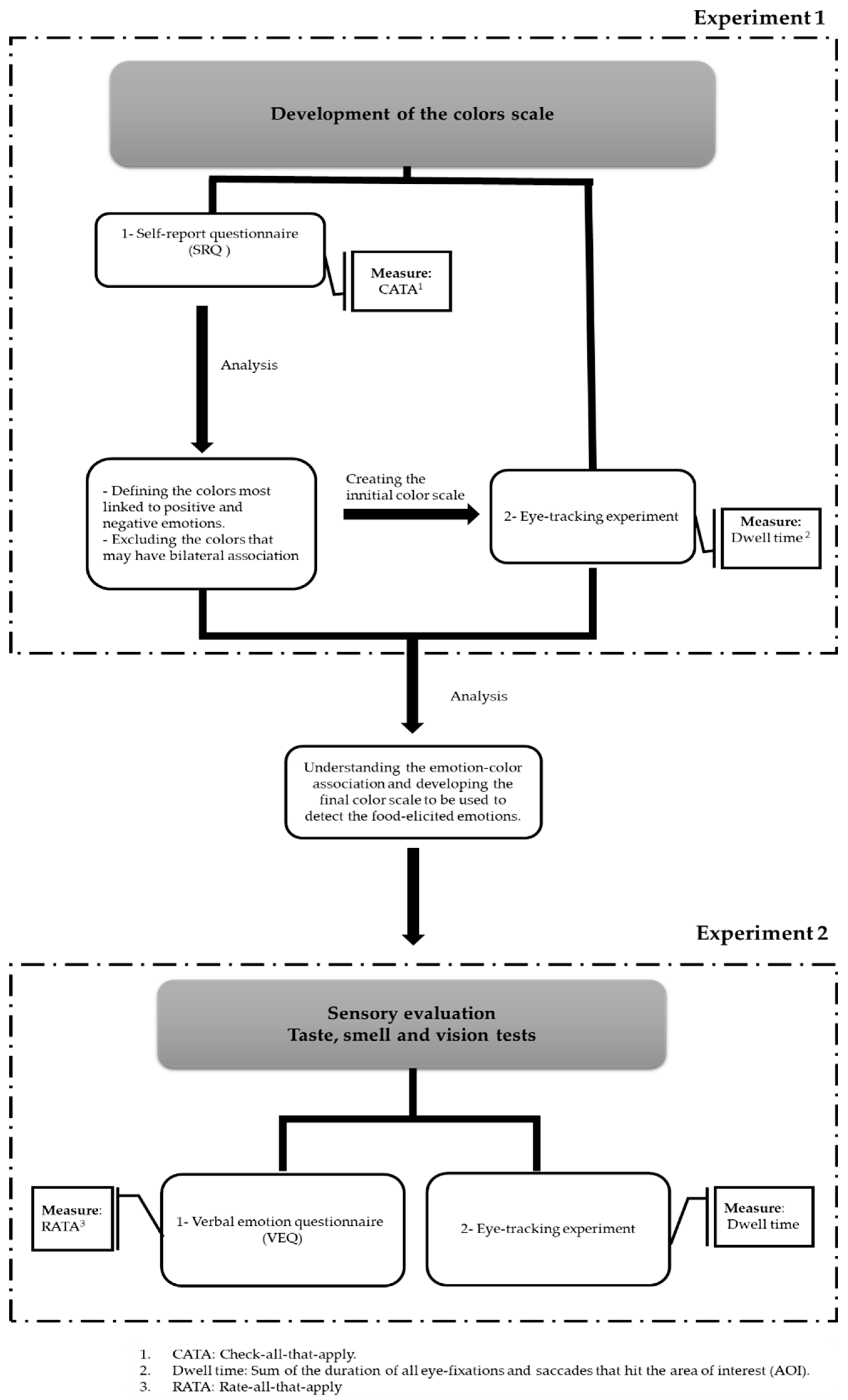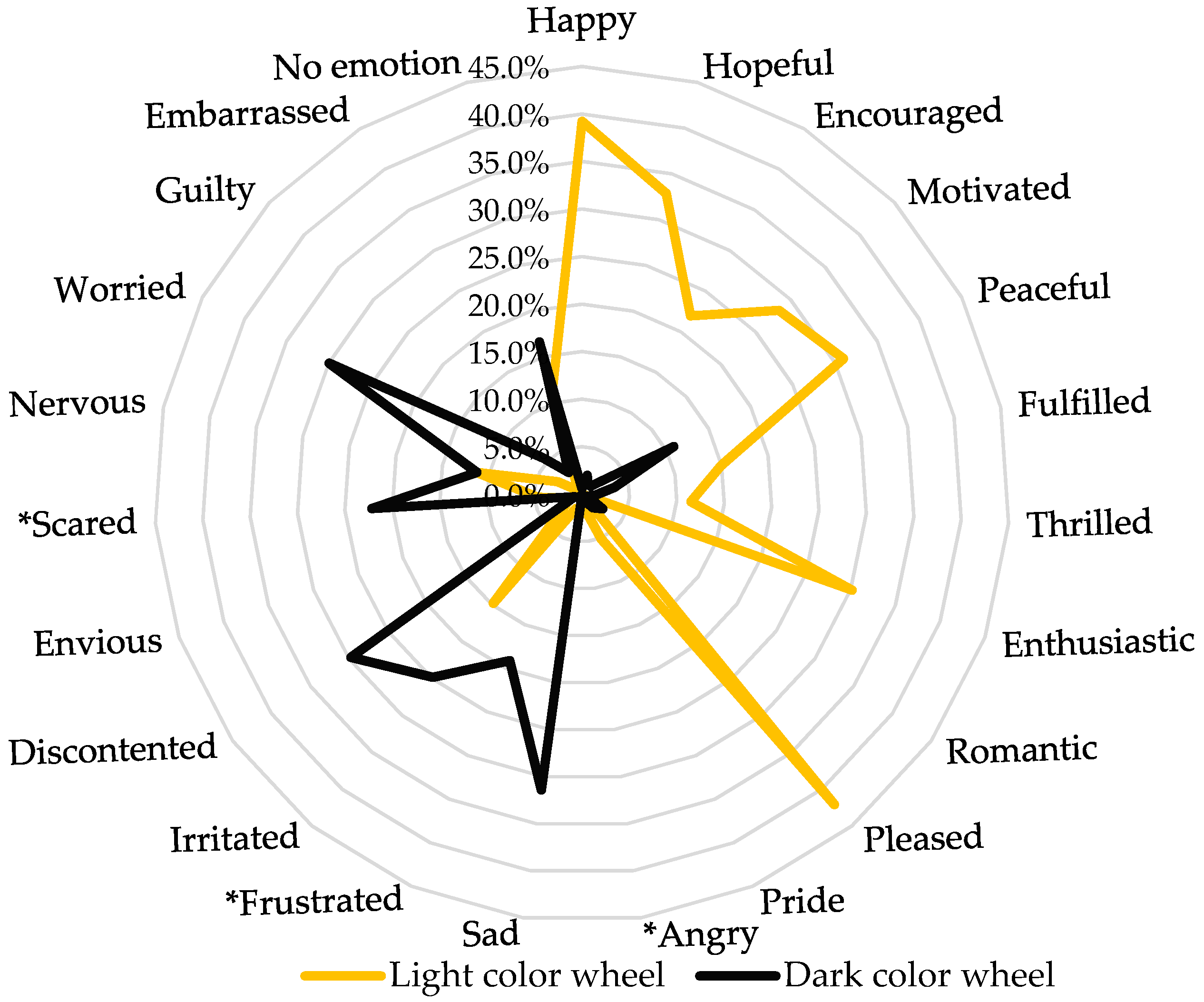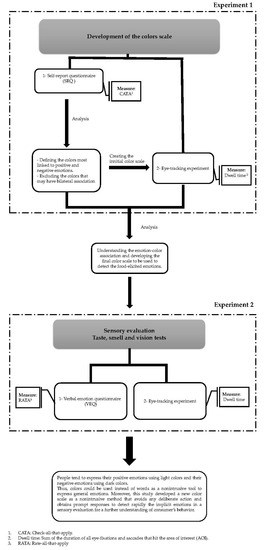Development of a Sensory Method to Detect Food-Elicited Emotions Using Emotion-Color Association and Eye-Tracking
Abstract
:1. Introduction
2. Materials and Methods
2.1. First Experiment: Developing the Color Scale Based on the Emotion-Color Association
2.1.1. Self-Reported Questionnaire
2.1.2. Procedures
2.1.3. Eye-Tracking Experiment
2.1.4. Procedures
2.1.5. Data Analysis
2.2. Second Experiment: Sensory Evaluation
2.2.1. Samples
2.2.2. Procedures
2.2.3. Data Analysis
3. Results
3.1. Self-Reported Questionnaire
The Characteristics of the Food in the Imagined Consumption Experience
3.2. Eye-Tracking Experiment
3.3. Sensory Evaluation
4. Discussion
4.1. Emotion-Color Association
4.2. Detecting the Food-Elicited Emotions Using the Developed Color Scale
5. Limitations and Suggestions for Further Research
Author Contributions
Funding
Acknowledgments
Conflicts of Interest
Appendix A



References
- Meiselman, H.L. A review of the current state of emotion research in product development. Food Res. Int. 2015, 76, 192–199. [Google Scholar] [CrossRef]
- Delarue, J.; Lawlor, B.; Rogeaux, M. Rapid Sensory Profiling Techniques: Applications in New Product Development and Consumer Research; Woodhead Publishing: Cambridge, UK, 2014; pp. 71–100. [Google Scholar]
- Mauss, I.B.; Robinson, M.D. Measures of emotion: A review. Cogn. Emot. 2009, 23, 209–237. [Google Scholar] [CrossRef] [PubMed]
- Laros, F.J.M.; Steenkamp, J.B.E.M. Emotions in consumer behavior: A hierarchical approach. J. Bus. Res. 2005, 58, 1437–1445. [Google Scholar] [CrossRef]
- Collinsworth, L.A.; Lammert, A.M.; Martinez, K.P.; Leidheiser, M.; Garza, J.; Keener, M.; Ashman, H. Development of a novel sensory method: Image Measurement of Emotion and Texture (IMET). Food Qual. Prefer. 2014, 38, 115–125. [Google Scholar] [CrossRef]
- Winkielman, P.; Berridge, K.C. Unconscious Emotion. Am. Psychol. Soc. 2004, 13, 120–123. [Google Scholar] [CrossRef]
- Dane, E.; Pratt, M.G. Exploring Intuition and its Role in Managerial Decision Making. Acad. Manag. Rev. 2007, 32, 33–54. [Google Scholar] [CrossRef] [Green Version]
- Leeuw, E.D.D.; Joop Hox, D.D. International Handbook of Survey Methodology; Routledge: Abingdon, UK, 2008. [Google Scholar]
- Tseng, K.C. Behavioral finance, bounded rationality, neuro-finance, and traditional finance. Invest. Manag. Financ. Innov. 2006, 3, 7–18. [Google Scholar]
- Beattie, G.; Sale, L. Shopping to Save the Planet? Implicit Rather than Explicit Attitudes Predict Low Carbon Footprint Consumer Choice. Int. J. Environ. Cult. Econ. Soc. Sustain. Annu. Rev. 2011, 7, 211–232. [Google Scholar] [CrossRef]
- Thomson, D.M.H.; Crocker, C.; Marketo, C.G. Linking sensory characteristics to emotions: An example using dark chocolate. Food Qual. Prefer. 2010, 21, 1117–1125. [Google Scholar] [CrossRef]
- Koola, P.M.; Benjamin, P.; Schatz, S.; Colombo, G. A Methodology for Capturing and Fusing Unconscious Cognition with Computation. Procedia Manuf. 2015, 3, 4129–4135. [Google Scholar] [CrossRef] [Green Version]
- Truong, K.P.; Neerincx, M.A.; Van Leeuwen, D.A. Measuring emotions using eye tracking Jakob. In Proceedings of the International Conference on Methods and Techniques in Behavioral Research, Maastrich, The Netherlands, 26–29 August 2008; p. 226. [Google Scholar]
- Hanada, M. Correspondence analysis of color–emotion associations. Color Res. Appl. 2018, 43, 224–237. [Google Scholar] [CrossRef]
- De Bortoli, M.; Maroto, J. Colours across cultures: Translating colours in interactive marketing communications. In Proceedings of the European Languages and the Implementation of Communication and Information Technologies (Elicit) Conference (Elicit 2001), Paisley, UK, 9–10 November 2001; pp. 3–4. [Google Scholar]
- Gil, S.; Le Bigot, L. Seeing Life through Positive-Tinted Glasses: Color–Meaning Associations. PLoS ONE 2014, 9, e104291. [Google Scholar] [CrossRef]
- Gilg, A.; Barr, S.; Ford, N. Green consumption or sustainable lifestyles? Identifying the sustainable consumer. Futures 2005, 37, 481–504. [Google Scholar] [CrossRef]
- Hemphill, M. A Note on Adults’ Color–Emotion Associations. J. Genet. Psychol. 1996, 157, 275–280. [Google Scholar] [CrossRef] [PubMed]
- Kaya, N.; Epps, H.H. Color-emotion associations: Past experience and personal preference. In Proceedings of the AIC 2004 “Color Paint” Interim Meeting of the International Color Association, Porto Alegre, Brazil, November 2004; pp. 31–34. [Google Scholar]
- Manav, B. Color-emotion associations and color preferences: A case study for residences. Color Res. Appl. 2007, 32, 144–150. [Google Scholar] [CrossRef]
- Piotrowski, C.; Armstrong, T. Color Red: Implications for applied psychology and marketing research. Psychol. Educ. 2012, 49, 55–57. [Google Scholar]
- Mahnke, F.H. Color, Environment, and Human Response: An Interdisciplinary Understanding of Color and Its Use as A Beneficial Element in The Design of The Architectural Environment; Wiley: Seoul, Korea, 1996. [Google Scholar]
- Kaya, N.; Epps, H.H. Relationship between Color and Emotion: A Study of College Students. Coll. Stud. J. 2004, 38, 396–405. [Google Scholar]
- Boyatzis, C.J.; Varghese, R. Children’s emotional associations with colors. J. Genet. Psychol. 1994, 155, 77–85. [Google Scholar] [CrossRef]
- Hupka, R.B.; Zaleski, Z.; Otto, J.; Reidl, L.; Tarabrina, N.V. The colors of anger, envy, fear, and jealousy: A cross-cultural study. J. Cross Cult. Psychol. 1997, 28, 156–171. [Google Scholar] [CrossRef]
- Kaya, N.; Crosby, M. Color associations with different building types: An experimental study on American college students. Color Res. Appl. 2006, 31, 67–71. [Google Scholar] [CrossRef]
- Manav, B. Color-emotion associations, designing color schemes for urban environment-architectural settings. Color Res. Appl. 2017, 42, 631–640. [Google Scholar] [CrossRef]
- Cimbalo, R.S.; Beck, K.L.; Sendziak, D.S. Emotionally Toned Pictures and Color Selection for Children and College Students. J. Genet. Psychol. 1978, 133, 303–304. [Google Scholar] [CrossRef]
- Lawler, C.O.; Lawler, E.E., III. Color-mood associations in young children. J. Genet. Psychol. 1965, 107, 29–32. [Google Scholar] [CrossRef] [PubMed]
- Gmuer, A.; Nuessli Guth, J.; Runte, M.; Siegrist, M. From emotion to language: Application of a systematic, linguistic-based approach to design a food-associated emotion lexicon German. Food Qual. Prefer. 2015, 40, 77–86. [Google Scholar] [CrossRef]
- Ares, G.; Jaeger, S.R. A comparison of five methodological variants of emoji questionnaires for measuring product elicited emotional associations: An application with seafood among Chinese consumers. Food Res. Int. 2017, 99, 216–228. [Google Scholar] [CrossRef] [PubMed]
- Hettiarachchi, A.A.; De Silva, N. Colour associated emotional and behavioural responses: A study on the associations emerged via imagination. Built Environ. Sri Lanka 2012, 11, 21–27. [Google Scholar] [CrossRef]
- Piqueras Fiszman, B.; Jaeger, S.R. The effect of product–context appropriateness on emotion associations in evoked eating occasions. Food Qual. Prefer. 2015, 40, 49–60. [Google Scholar] [CrossRef]
- Lang, P.J.; Greenwald, M.K.; Bradley, M.M.; Hamm, A.O. Looking at pictures: Affective, facial, visceral, and behavioral reactions. Psychophysiology. 1993, 30, 261–273. [Google Scholar] [CrossRef]
- Royet, J.P.; Zald, D.; Versace, R.; Costes, N.; Lavenne, F.; Koenig, O.; Gervais, R. Emotional Responses to Pleasant and Unpleasant Olfactory, Visual, and Auditory Stimuli: A Positron Emission Tomography Study. J. Neurosci. 2000, 20, 7752–7759. [Google Scholar] [CrossRef]
- Olofsson, J.K.; Nordin, S.; Sequeira, H.; Polich, J. Affective picture processing: An integrative review of ERP findings. Biol. Psychol. 2008, 77, 247–265. [Google Scholar] [CrossRef] [Green Version]
- Calvo, M.G.; Lang, P.J. Gaze Patterns When Looking at Emotional Pictures: Motivationally Biased Attention. Motiv. Emot. 2004, 28, 221–243. [Google Scholar] [CrossRef]
- Foti, D.; Hajcak, G.; Dien, J. Differentiating neural responses to emotional pictures: Evidence from temporal-spatial PCA. Psychophysiology. 2009, 46, 521–530. [Google Scholar] [CrossRef] [PubMed]
- Xing, C.; Isaacowitz, D.M. Aiming at Happiness: How Motivation Affects Attention to and Memory for Emotional Images. Motiv. Emot. 2006, 30, 243–250. [Google Scholar] [CrossRef]
- Meyners, M.; Castura, J.C.; Carr, B.T. Existing and new approaches for the analysis of CATA data. Food Qual. Prefer. 2013, 30, 309–319. [Google Scholar] [CrossRef]
- Danner, L.; Sidorkina, L.; Joechl, M.; Duerrschmid, K. Make a face! Implicit and explicit measurement of facial expressions elicited by orange juices using face reading technology. Food Qual. Prefer. 2014, 32, 167–172. [Google Scholar] [CrossRef]
- Acker, F. Conscious versus unconscious thought. Judgm. Decis. Mak. 2008, 3, 292–303. [Google Scholar]
- Richins, M.L. Measuring Emotions in the Consumption Experience. J. Consum. Res. 1997, 24, 127–146. [Google Scholar] [CrossRef]
- Thompson, E.R. Development and Validation of an Internationally Reliable Short-Form of the Positive and Negative Affect Schedule (PANAS). J. Cross Cult. Psychol. 2007, 38, 227–242. [Google Scholar] [CrossRef]
- Kühn, S.; Brass, M. Retrospective construction of the judgement of free choice. Conscious. Cogn. 2009, 18, 12–21. [Google Scholar] [CrossRef] [PubMed]










| Experiment | Gender (%) | Age (Years) | Number of Participants | ||
|---|---|---|---|---|---|
| Developing the Color Scale | Self-reported questionnaire | Male | 21% | 18–88 | 487 |
| Female | 79% | ||||
| Eye-tracking | Male | 37% | 18–30 | 30 | |
| Female | 63% | ||||
| Sensory Evaluation | Male | 35% | 19–48 | 40 | |
| Female | 65% | ||||
| Food that Evoked | The Features of the Food | Frequency |
|---|---|---|
| Positive emotions | Healthy/ environmentally-friendly, and tasty | 75.0% |
| Tasty, even though it was neither healthy nor environmentally-friendly | 45.4% | |
| Healthy, even though it was not tasty | 5.0% | |
| Environmentally-friendly, even though it was not tasty | 2.1% | |
| Negative emotions | Tasty, but it was neither healthy nor environmentally-friendly | 51.4% |
| Healthy, but it was not tasty | 48.3% | |
| Environmentally-friendly, but it was not tasty | 40.1% |
| Sample | General Positive Emotion | General Negative Emotion | Dwell Time LCS (ms) | Dwell Time DCS (ms) |
|---|---|---|---|---|
| * E, D Apple | 2.8 | 1.2 | 4383.2 | 827.7 |
| * E, D Orange juice | 2.6 | 1.4 | 3303 | 520.6 |
| * E, D Walnuts | 2.4 | 1.1 | 2853.3 | 1339.4 |
| * E, D Oregano | 2.6 | 1.4 | 2825.6 | 1348.1 |
| * E, D Red bell pepper | 1.9 | 1.3 | 3016.6 | 1344.8 |
| * E Coffee | 2.5 | 1.3 | 2363.3 | 1951.3 |
| Orange juice bottle | 1.9 | 1.7 | 2746.3 | 1359.3 |
| * E, D Pear | 2.2 | 1.2 | 3486.4 | 609.9 |
© 2019 by the authors. Licensee MDPI, Basel, Switzerland. This article is an open access article distributed under the terms and conditions of the Creative Commons Attribution (CC BY) license (http://creativecommons.org/licenses/by/4.0/).
Share and Cite
Ismael, D.; Ploeger, A. Development of a Sensory Method to Detect Food-Elicited Emotions Using Emotion-Color Association and Eye-Tracking. Foods 2019, 8, 217. https://doi.org/10.3390/foods8060217
Ismael D, Ploeger A. Development of a Sensory Method to Detect Food-Elicited Emotions Using Emotion-Color Association and Eye-Tracking. Foods. 2019; 8(6):217. https://doi.org/10.3390/foods8060217
Chicago/Turabian StyleIsmael, Diana, and Angelika Ploeger. 2019. "Development of a Sensory Method to Detect Food-Elicited Emotions Using Emotion-Color Association and Eye-Tracking" Foods 8, no. 6: 217. https://doi.org/10.3390/foods8060217
APA StyleIsmael, D., & Ploeger, A. (2019). Development of a Sensory Method to Detect Food-Elicited Emotions Using Emotion-Color Association and Eye-Tracking. Foods, 8(6), 217. https://doi.org/10.3390/foods8060217






